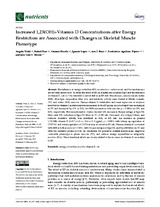Mostrar el registro sencillo del ítem
Increased 1,25(OH)2-Vitamin D Concentrations after Energy Restriction Are Associated with Changes in Skeletal Muscle Phenotype
| dc.contributor.author | Vidal, Ángela | |
| dc.contributor.author | Ríos, Rafael | |
| dc.contributor.author | Pineda, Carmen | |
| dc.contributor.author | López, Ignacio | |
| dc.contributor.author | Raya, Ana I. | |
| dc.contributor.author | Aguilera Tejero, Escolástico | |
| dc.contributor.author | López Rivero, J.L. | |
| dc.date.accessioned | 2021-02-15T08:05:59Z | |
| dc.date.available | 2021-02-15T08:05:59Z | |
| dc.date.issued | 2021 | |
| dc.identifier.uri | http://hdl.handle.net/10396/21073 | |
| dc.description.abstract | The influence of energy restriction (ER) on muscle is controversial, and the mechanisms are not well understood. To study the effect of ER on skeletal muscle phenotype and the influence of vitamin D, rats (n = 34) were fed a control diet or an ER diet. Muscle mass, muscle somatic index (MSI), fiber-type composition, fiber size, and metabolic activity were studied in tibialis cranialis (TC) and soleus (SOL) muscles. Plasma vitamin D metabolites and renal expression of enzymes involved in vitamin D metabolism were measured. In the ER group, muscle weight was unchanged in TC and decreased by 12% in SOL, but MSI increased in both muscles (p < 0.0001) by 55% and 36%, respectively. Histomorphometric studies showed 14% increase in the percentage of type IIA fibers and 13% reduction in type IIX fibers in TC of ER rats. Decreased size of type I fibers and reduced oxidative activity was identified in SOL of ER rats. An increase in plasma 1,25(OH)2-vitamin D (169.7 ± 6.8 vs. 85.4 ± 11.5 pg/mL, p < 0.0001) with kidney up-regulation of CYP27b1 and down-regulation of CYP24a1 was observed in ER rats. Plasma vitamin D correlated with MSI in both muscles (p < 0.001), with the percentages of type IIA and type IIX fibers in TC and with the oxidative profile in SOL. In conclusion, ER preserves skeletal muscle mass, improves contractile phenotype in phasic muscles (TC), and reduces energy expenditure in antigravity muscles (SOL). These beneficial effects are closely related to the increases in vitamin D secondary to ER. | es_ES |
| dc.format.mimetype | application/pdf | es_ES |
| dc.language.iso | eng | es_ES |
| dc.publisher | MDPI | es_ES |
| dc.rights | https://creativecommons.org/licenses/by/4.0/ | es_ES |
| dc.source | Nutrients 13(2), 607 (2021) | es_ES |
| dc.subject | Energy restriction | es_ES |
| dc.subject | Muscle | es_ES |
| dc.subject | Vitamin D | es_ES |
| dc.subject | Rat | es_ES |
| dc.title | Increased 1,25(OH)2-Vitamin D Concentrations after Energy Restriction Are Associated with Changes in Skeletal Muscle Phenotype | es_ES |
| dc.type | info:eu-repo/semantics/article | es_ES |
| dc.relation.publisherversion | http://dx.doi.org/10.3390/nu13020607 | es_ES |
| dc.relation.projectID | Instituto de Salud Carlos III. PI17/00169 | es_ES |
| dc.rights.accessRights | info:eu-repo/semantics/openAccess | es_ES |

